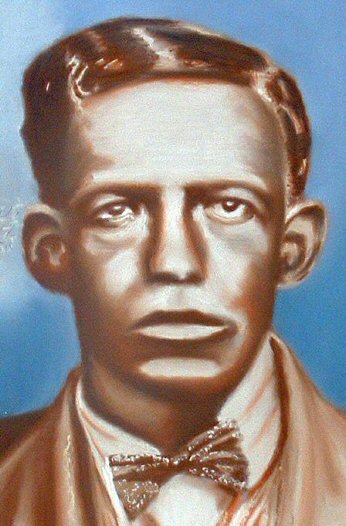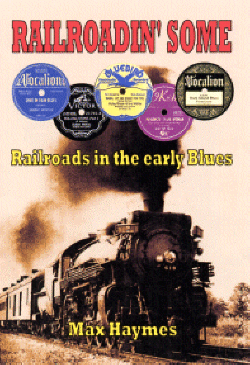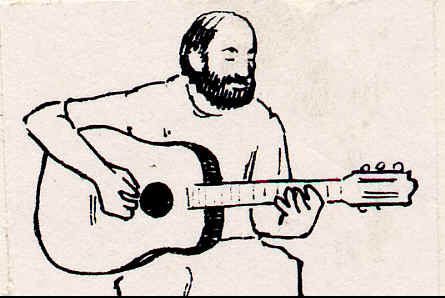
Painting © 2004 Loz
Arkle
Website
© Copyright 2000-2011 Alan White - All
Rights Reserved
Site optimised for Microsoft Internet Explorer



"T C I Blues" by Max Haymes
In “78 ¼ly”, No 11, Gayle Wardlow stated that the above initials stood for “Tennessee Corp & Inor Co, a big steel mill in the Birmingham area”(1). While this seems a quite reasonable explanation, I feel that a company with a far higher profile, also in the Birmingham area, is the more likely candidate. This was the Tennessee Coal, Iron & Railroad Company, which eventually became a part of the giant United States Steel Corporation early in the 20th century. As one of Alabama’s most avid chroniclers, Ethel Armes, put it, the coming of the T C I & RR Co “into the Birmingham district in 1886 is perhaps the most significant event in southern coal and iron records of this interesting year”(2). The T C I were based in Nashville and included a furnace (for iron ore) nearly 90 miles down the line at Cowan, Tenn., not far from the Alabama border. Cowan was reached by the Nashville & Chattanooga RR in 1852 on its way down to Chattanooga, Tenn.
The T C I & RR Co started life as a mining concern called the Sewanee Mining Company which in 1853 decided on “the construction of its 19 mile railroad from a junction with the Nashville & Chattanooga RR at Cowan” (3).
Part of the N C & St L system in
the early 1920s
The latter railroad had been chartered in 1845 but its first trains did not have a line to run on until 1851. With various mergers of small companies, by 1873 it had been re-named the Nashville, Chattanooga & St Louis Railway, sometimes referred to as “the Dixie Line” and later on the “Lookout Mountain route”. This in turn in 1880, “as a means of eliminating the threat of competition that was developing…at that time” (4) was acquired by the Louisville & Nashville (L & N) but continued to operate under its own name. The N C & St L featured famous express trains such as the Dixie Flyer and Dixie Limited amongst others. The Flyer was celebrated in a Bessie Smith title in 1925 as “Dixie Flyer Blues” and also as a harmonica train solo by De Ford Bailey some two years later. Both artists reputedly hailed from the Nashville area. In 1866 the Sewanee Mining Co was absorbed by the Tennessee Coal & Railroad Company which by 1881 changed to the Tennessee Coal, Iron & RR Company who sold “its main line tracks (to) the N C & St L Ry”(5) in 1886. By the beginning of 1887 the N C & St L had taken over the remaining branch lines.
Meanwhile some ten years earlier in Alabama, a rich coal deposit known as the “Browne coal seam” had been found by a Mr Aldrich “to underlie the vast (Warrior coal) field for miles and miles. Its name was at length changed from Browne to Pratt in honour of Daniel Pratt, who’s moneys were to be used in it's first large development”(6). The latter was a central entrepreneurial figure in the progress of industrialisation in Alabama and Pratt City was named for him. This later became part of Greater Birmingham.

One of the locomotives used on the T C I & RR. Co. prior to the takeover by the
N C & St L in 1887
The city formed the title of a song by at least two Blues singers: Bertha ‘Chippie’ Hill and pianist Jabo Williams. Pratt was also remembered in the name of the first large coal mining company to appear in Alabama. This was the Pratt Coal & Coke Company which was organised in January 1878. This was the year following Aldrich’s discovery of the Browne coal seam. Indeed he was to be appointed superintendent and mine manager along with “H F DeBardeleben, president, (and) J W Sloss, secretary and treasurer”(7).
This followed on from the major success of the experiment to make iron with coke (pig iron) at the Oxmoor furnace just outside Birmingham. By 1886 the Pratt Coal & Coke Co had been taken over by their deadly rivals, the T C I & RR Co, also known as the Coal & Pig Iron Route. It would seem that this had been on the cards for some three years. During 1883, treasurer Sloss had been to Tennessee. He noted in a report that at the furnace in Cowan, they used convict labour (which would be predominantly black) and yet Cowan claimed iron was expensive as it cost $12.50 per ton to produce. Sloss explained his interest in this furnace as it was owned by the T C I & RR Co. The convict labour referred to the barbaric convict-lease system and no doubt attracted Sloss as it was cheap. (not only in wages but also in human lives) to operate. He maintained “I believe, when we taken into consideration the convict labour, iron ought to be made at Cowan for $11.90 per ton”(8).
As with the T C I, most coal mines were owned by railroad companies (or vice versa) and were a major source of employment for black convicts. The L & N, even if indirectly, was a major beneficiary of the convict-lease system in Alabama. The Birmingham Mineral Railroad (owned and run by the L & N) and the South & North Alabama RR, which was later taken over by the L & N, virtually monopolised the iron and coal traffic in the Birmingham area [1]. In fact it was ‘near the village of Elyton and at the point where the Alabama Great Southern Railroad…crosses the South & North Alabama Railroad” (9) that Birmingham was founded in 1871. The AGS was to form part of the Southern Railway after 1894. The Louisville & Nashville can be seen as the prime mover in the creation of Birmingham, Alabama.
Throughout the US by the 1900s, “the railroad companies, controlling over 80 per cent of the output of coal, had the marketing situation in the palm of the hand” (10). Another railroad, the Birmingham Railway, Light & Power Company ran its main line out to Ensley and it was at the latter location the first steel “in commercial quantities” was made in Birmingham by T C I in late 1899 (11).

First box car
of steel from T C I & RR Co circa 1900.
Note ‘L & N’ legend above the commemorative plaque.
Like the coal mines, the steel mill at Ensley would employ virtually all black labour and conditions were harsh at the best of times; as Blind Blake[2]graphically relates on his “Steel Mill Blues” in 1927.
“Workin’ in the steel mill, makin’ pig iron all day. (x 2)
When I come home mama, have somewhere for me to lay.”“When I look into that blast furnace, it’s all red hot with ore,
When I look into the blast furnace, it’s all red hot with ore.
If I catch you stealin’ ain’t goin’ back no more.”“Pig iron an’ steel eatin’ out all of my shoes. (x 2)
That’s the reason why I got those low-down ‘Steel Mill Blues’.” (12)
The main difference between this job and convict-lease being that workers at the Ensley plant got paid as employees rather than being cruelly treated or killed as convicts. The convict-lease system had been operated by every state in the South and as far north as Kentucky; but the last state to abolish this evil system was Alabama, in 1928. The same state of course where the Tennessee-based T C I had such a massive vested interest. As too did the Southern and L & N railroads “each of whom agreed to purchase T C I & RR bonds in the amount of $250,000 to help finance the construction" (13) of the Ensley plant opened in 1899.

The New
Ensley Blast Furnaces, T C I c. 1900
However, not all mining companies in Alabama should be tarred with the same brush. Some were employing paid operators, both black and white, who were beginning to rebel against the often dangerous and unhealthy conditions in the mines. They were getting organised into unions to fight in their corner. This was also happening in other states such as West Virginia and between 1915 and 1932 the mining companies attempted to counteract this trend. “In their growing efforts to stem the tide of working-class militancy and discontent, the major coal companies sponsored mine safety programmes, hired social workers, and subsidised the public school system[3], as well as supporting private churches, social clubs, and fraternal organisations.” (14).
The churches would have provided such groups as the T C I Women’s Four and the T C I Sacred Singers. The former cut two sides for Paramount in 1927 “That Great Day / I Got a Home In That Rock”. While the social clubs and fraternal organisations could have spawned the secular coupling by the T C I Section Crew made at the same session: “Track Linin’” / “Section Gang Song”. As Cohen observed, these recordings “strongly suggested that these singers were …. a choir – either from a commercial firm (such as the Tennessee Coal and Iron Company) or from school – that was recreating several pieces, both sacred and secular, for commercial purposes”. (15).
The T C I & RR Co. were obviously also trying to distance themselves from murkier links with the past in the days of their involvement with the convict-lease system, As indeed did the L & N and the N C & St L railroads. The latter severed ties with the T C I c. 1906. Some major railroad companies also sponsored a cappella groups in the recording studios. These included the Missouri Pacific and the Illinois Central. From 1928 to 1930 the I C Glee Club Quartet recorded 20 sides for the Okeh label. As well as sacred items this group also included secular numbers such as “I’m Going Home On The Chickasaw Train” (sic), “Riding on The Seminol” (sic), and “Panama To Chi”. The Panama Limited, (Chapter 1 of book) the Chickasaw and the Seminole Limited were all crack express trains on the I C in the 1920’s and 30’s. If the personnel on these sides are the same as on the initial (unissued) session in early 1928, then these singers were all employed by the Illinois Central variously as labourer, porter, springman and pipefitter helper. (16).
II
As an addendum it might be of interest to point out that via the S & N A and the Birmingham Mineral RR, the L & N also gleaned the rich pickings some seven miles south of Birmingham. This was part of “that famous one hundred mile range of iron ore known as Red Mountain,” (17). Described by Armes as “the hill of the wine-red rock” it contained rich deposits of red ore, often a mile or more below ground. In Jefferson County, where Birmingham is situated, “Three crude iron making ventures were started in the eighteen-sixties” which included “the Red Mountain Iron Company Works (or the Oxmoor furnaces) owned at the present time (1910) by the Tennessee Coal, Iron and Railroad Company”. (18).
By 1910 business was booming for the T C I, L & N, and many other companies in the steel and coal industries in Alabama. But things were very different in the depression-torn ‘30’s, as elsewhere in the US. President Franklin D. Roosevelt introduced the famous ‘alphabet policies’ including the C W A, C C C and the W P A. Employing both black and white musicians, one project of the W P A “which will be long remembered, was the placing of the statue of Vulcan, which had been at the Fairgrounds since 1906… up on a 124 foot predestal (sic) on Red Mountain – the very mountain of ore from which it was made”. (19). The original line on the Birmingham Mineral RR “extended from a junction with the S & N A at Magella, Ala. (about three miles south of Birmingham) for a distance of about seven and one-half miles along the northern base of Red Mountain to what later became the town of Bessemer” (20).
Bessemer founded in 1887 was to become a steel town which was immortalised in the names of cappella groups such as the Bessemer Sunset Four and the Bessemer Melody Boys. As well as forming part of the title for Ma Rainey’s “Bessemer Bound Blues” in 1925 and “Bessemer Blues” by Tampa Red in 1939, this town featured in the Jazz Gillum 1937 recording of “Birmingham Blues”. It was “named in honor of Henry Bessemer, the inventor of the world’s premier steelmaking system”. (21).
Vulcan, whose statue was referred to earlier on the top of Red Mountain, was a Roman God (the god of fire and also the smith god) whose smithy was reputedly deep down in the ground below a volcano (Mt Etna) in Sicily. This was entirely in keeping with the cultural / social beliefs of the area. Like Louisiana, Georgia and South Carolina, Alabama was steeped in the lore of hoodoo. Bessie Smith probably had Bessemer in mind when she cut her “Red Mountain Blues” in 1925. The town being situated some 13 miles (or 12 according to Gillum) from Birmingham, which was also known as the “Magic City”. By the time of her recording, the L & N encircled Red Mountain so that Bessie could go round it with the greatest of ease. She wants to consult a fortune teller (or hoodoo doctor) to ‘fix ‘her man (and his dinner!) so that he would come back to her.
“Down in the valley, my head was hangin’ low;
My poor heart was achin’. Gee! It hurt me so.
Fortune Teller told me what I had to do;
Get myself some snake-root, stir it in the stew;
Got myself some snake-root, yonder comes the stew.
Fuse them both together, I know what they will do.
Put some in my pocket, put some in my boot;
That don’t make him love me, I’ll start right in to shoot”
“Goin’ round Red Mountain in a hurry;
I’m goin’ where I can change my mind.
An’ if I can’t get rid of all my worries;
Then I’ll be gone for a long, long time.” (22).
Although the T C I (and the Red Mountain Iron Co.) had become a subsidiary of United States Steel as already stated, some two decades prior to Bessie’s recording; the Nashville-based company would still be operating under it’s own name in the 1920’s and continued to be a major presence in the Birmingham / Bessemer area of Alabama.
Finally, there appears to be only one other title referring to Red Mountain by a black artist in the pre-war era. This was a side simply called “Red Mountain” made for the Library of Congress between 1926 and 1928 in the Darien area of Georgia. The unaccompanied singer (a T C I worker?) is listed in B & G R as a “G. Carter”. Possibly inspired by the Smith song, this could be the same artist (if male!) as the Georgia 12-string guitarist George Carter who recorded four sides at a single session c. Feb 1929.
Notes
| 1 | Wardlow G. | p. 104 |
| 2 | Armes E. | p. 360 |
| 3 | Prince R E | p. 6 |
| 4 | Ibid | p. 5 |
| 5 | Ibid | p. 6 |
| 6 | Armes | Ibid p. 273 |
| 7 | Ibid | |
| 8 | Ibid | p. 305 |
| 9 | Herr K A | p. 140 |
| 10 | Bogen J I | p. 215 |
| 11 | McMillan M C | p. 66 |
| 12 | “Steel Mill Blues” | Blind Blake vo. Gtr. C. -/10/27. Chicago, Ill. |
| 13 | Herr Ibid | p. 75 |
| 14 | Trotter J W | p. 65 |
| 15 | Cohen N | p. 646 |
| 16 |
Dixon R M W, J Godrich & H W Rye |
see p. 420 |
| 17 | Armes | Ibid |
| 18 | Ibid | p. 161 |
| 19 | McMillan Ibid | p. 148 |
| 20 | Armes | Ibid |
| 21 | Cline W | p. 128 |
| 22 | “Red Mountain Blues” | Bessie Smith vo.; Don Redman clt.; Fletcher Henderson pno. 20/11/25. New York City. N Y |
References
| 1 | Armes Ethel | The Story of Coal and Iron In Alabama”. Arno Press N Y 1973 (Rep) 1st. pub 1910 |
| 2 | Herr Kincaid A | “The Louisville & Nashville R R 1850 – 1942” L & N Magazine, Louisville Ky. Publisher. August 1943 |
| 3 | Bogen Jules I | “The Anthracite Railroads”. The Ronald Press Co. New York 1927 |
| 4 | Cohen Norm | “Long Steel Rail”. University of Illinois Press. Urbana. 1981 |
| 5 | Trotter Jr J W | “Coal, Class and Color” (Blacks in Southern West Virginia 1915-1932). University of Illinois Press. 1990 |
| 6 | McMillan Malcolm C | “Yesterday’s Birmingham”. E A Seeman Publishing Inc. Miami Fla. 1975 |
| 7 | Wardlow Gayle | “78 Quarterly” No. 11 Pete Whelan (Ed.) Key West, Fla. 2000 |
| 8 | Prince Richard E | “Nashville, Chattanooga & St Louis Railway”. Indiana University Press. 2001 (Rep.) 1st. pub. 1967 |
| 9 | Dixon Robert M W , John Godrich, Howard W Rye | “Blues & Gospel Records 1890-1943” (4th Ed. Revised) Clarendon Press. Oxford. 1997 |
| 10 | Cline Wayne | “Alabama Railroads”. The University of Alabama Press. Tuscaloosa & London 1997 |
| 11 | Discographical Details B & G R | Ibid |
| 12 | Transcriptions by Max Haymes, 2002 |
An excerpt, adapted for current publication, from “An’ That Thing Don’t Keep – A Ringing So Soon” – Ch. 6 featured in forthcoming book “Railroadin’ Some” (Railroads in the Early Blues) by Max Haymes; publication by Cambridge University Press pending,
Copyright © 2003 Max Haymes. All rights reserved.




